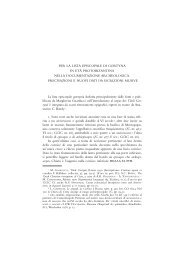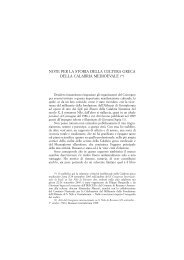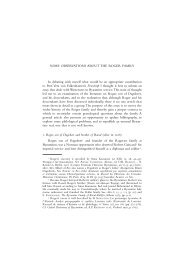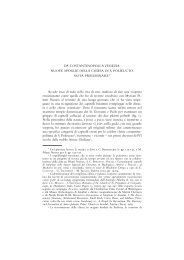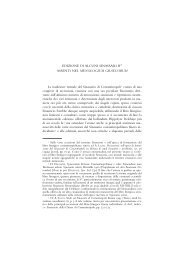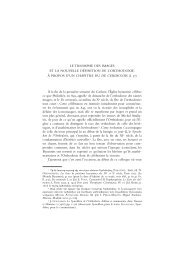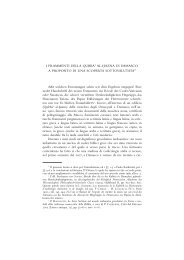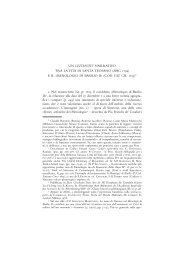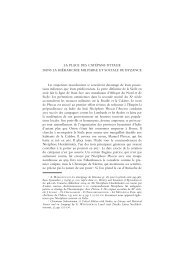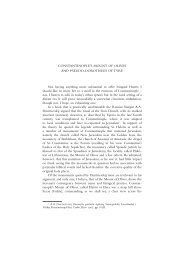Cyril Mango
Cyril Mango
Cyril Mango
Create successful ePaper yourself
Turn your PDF publications into a flip-book with our unique Google optimized e-Paper software.
30<br />
CYRIL MANGO<br />
St. Matthew’s Gospel written in the hand of Barnabas that had been<br />
found in Cyprus 36 , an incident dated by Victor Tunnunensis to 488 37 .<br />
From the reign of Heraclius onwards the chapel in question is repeatedly<br />
mentioned as a venue for imperial coronations and weddings 38 and it<br />
figures prominently in the Book of Ceremonies 39 . There is, however, no<br />
independent confirmation that it had been built by Pulcheria. That, it<br />
may be thought, is not too serious an objection, but what is odd is that<br />
the famous dexia plays no part whatever in imperial ceremonial 40 , indeed<br />
is never alluded to, unless I am mistaken, until the 12th century, when it<br />
appears, along with a multitude of other relics, in the capella imperatoris,<br />
i.e. St. Mary of the Pharos 41 . That being so, I am a little surprised that<br />
Ioli Kalavrezou should describe St. Stephen’s arm as «enriching imperial<br />
ceremonial and strengthening the position of the emperor» 42 .<br />
Furthermore, the very translation as described by Theophanes finds<br />
no corroboration in other sources (for Proclus see below).This has been<br />
shown at length by J. Wortley 43 , to whose demonstration we may add<br />
one further text, namely the 9th-century 44 Brussels Chronicle, which<br />
devotes particular attention to the arrival of saints’ relics at Constantinople.<br />
For the reign of Theodosius II it records only that «the relics of the<br />
36 THEODORUS ANAGNOSTES, Kirchengeschichte, ed. G.C. HANSEN, Berlin 1971 (Die<br />
griechischen christlichen Schriftsteller der ersten Jahrhunderte, 54), p. 121, Nr.436.<br />
Cf. CEDRENUS, I,p.619; ALEXANDER MONACHUS, Laudatio Barnabae, ed. P. VAN DEUN,<br />
Turnhout-Leuven 1993 (Corpus Christianorum. Series Graeca, 26), p. 118 (in the<br />
chapel of the palace).<br />
37 Monumenta Germaniae Historica, Auct. ant., XI,p.191.<br />
38 THEOPHANES, ed. DE BOOR, pp.299, 300, 769; CONSTANTINUS PORPHYROGE-<br />
NITUS, De Cerimoniis, Bonn ed., I, pp. 196-197, 208, 212, 628.<br />
39 See J. EBERSOLT, Le Grand Palais de Constantinople, Paris 1910, pp.52-53.<br />
40 The contents of St. Stephen’s chapel, listed in De Cerimoniis,p.640, were limited<br />
to «the great cross of St. Constantine», three sceptres and a few other objects of<br />
secular ceremonial.<br />
41 P. RIANT, Exuviae sacrae Constantinopolitanae, Geneva 1877, II, pp. 211-212,but<br />
absent from the comprehensive listing by ANTONY OF NOVGOROD, Kniga Palomnik,<br />
ed. Chr. LOPAREV, Pravoslavnyj Palestinskij Sbornik 51 (1899), pp. 18-19.<br />
42 Helping Hands for the Empire, in Byzantine Court Culture from 829 to 1204, ed.<br />
H. MAGUIRE, Washington, DC 1997, p.66.<br />
43 The Trier Ivory Reconsidered, in Greek, Roman and Byzantine Studies 21 (1980),<br />
pp. 381-394.<br />
44 It is usually dated to the 11th century, but its final part is a bare list of emperors<br />
from Basil I to Romanus III, no doubt added by a later copyist.The fact that the<br />
Brussels Chronicle is the only Byzantine text to give the exact date of the first<br />
Russian attack on Constantinople (860) strongly suggests that it was compiled soon<br />
after that event.



